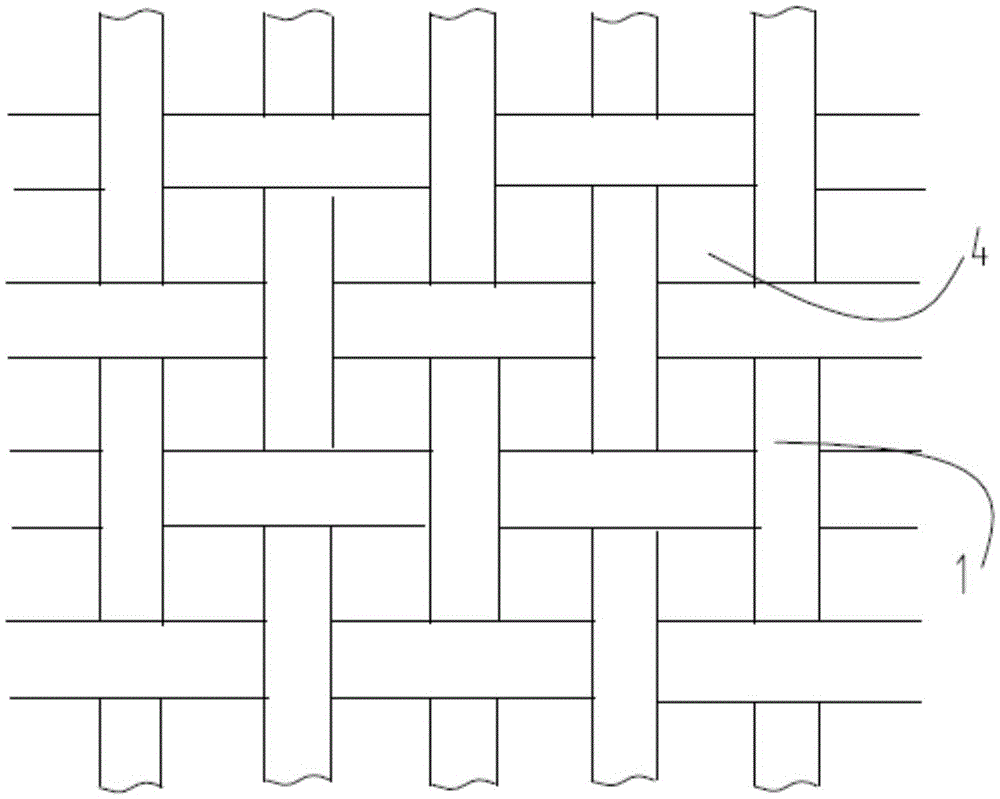Novel functional fabric
A functional and functional fiber technology, used in fabrics, textiles, textiles and papermaking, etc., can solve problems such as low efficiency, and achieve the effects of not easily lost, accelerated evaporation, and enhanced thermal insulation performance.
- Summary
- Abstract
- Description
- Claims
- Application Information
AI Technical Summary
Problems solved by technology
Method used
Image
Examples
Embodiment 1
[0019] figure 1 It is a schematic diagram when the fabric is not deformed, figure 2 It is a schematic diagram of the fabric deformed by water, image 3 Schematic diagram of the structure of the core-spun yarn. Such as figure 1 , figure 2 and image 3 As shown, what this embodiment provides is a new type of functional fabric, the yarn of the new type of functional fabric is a core-spun yarn 1, and the yarn core part 2 is composed of a functional fiber that heats up and stores heat. Part 3 is composed of a functional fiber that is beneficial to dehumidification; the functional fiber that raises temperature and stores heat is composed of conventional fiber materials accounting for 99.91% of the total weight of the yarn core part 2 and 0.09% of the total weight of the yarn core part 2 The nano-units in parts by weight are melt-spun; the functional fiber that is beneficial to dehumidification is a fiber that has a smaller curling rate when encountering water; the nano-units ...
Embodiment 2
[0024] The difference between Embodiment 2 and Embodiment 1 is that: the functional fibers for heat storage and heat storage are composed of conventional fiber materials accounting for 99.95% of the total weight of the yarn core part 2 and 0.05% of the total weight of the yarn core part 2. The nano-units of the weight part are melt-spun; the nano-units include microparticles of 9000 nanometers, and the microparticles include 500 weight units of zinc, 350 weight units of aluminum and 350 weight units of iron; the yarn core part 2 The twist number is 200T / m; the twist number of the winding part 3 is 200T / m.
Embodiment 3
[0026] The difference between Embodiment 3 and Embodiment 1 is that: the functional fiber for heating and storing heat is composed of conventional fiber materials accounting for 99.93% of the total weight of the yarn core part 2 and 0.07% of the total weight of the yarn core part 2 The nano-units of the weight part are melt-spun; the nano-units include 8700 nanometer particles, and the micro-particles include 400 weight units of zinc, 400 weight units of aluminum and 250 weight units of iron; the yarn core part 2 The twist number is 150 T / m; the twist number of the winding part 3 is 150 T / m.
PUM
 Login to View More
Login to View More Abstract
Description
Claims
Application Information
 Login to View More
Login to View More - R&D
- Intellectual Property
- Life Sciences
- Materials
- Tech Scout
- Unparalleled Data Quality
- Higher Quality Content
- 60% Fewer Hallucinations
Browse by: Latest US Patents, China's latest patents, Technical Efficacy Thesaurus, Application Domain, Technology Topic, Popular Technical Reports.
© 2025 PatSnap. All rights reserved.Legal|Privacy policy|Modern Slavery Act Transparency Statement|Sitemap|About US| Contact US: help@patsnap.com



